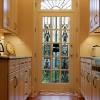
Looking to isolate sound? You found the right guys. Top notch products, impeccable advice, you are in the right place to plan your project and source the products you ACTUALLY need! Damping is a straightforward concept defined as the rate at which something dissipates energy. Higher damping equals higher energy dissipation. Without decoupling, generally the most efficient way to isolate vibrations is to dampen. Dampening methods include constrained layer damping or extensional damping. Inadvertently creating a triple leaf in construction when attempting to isolate sound is one of the most common mistakes we see in new construction and remodels.
Our proprietary isolation door designs have full sound tests from the most accurate acoustics lab in the country in both individual and communicating door assemblies. Each door arrives pre-hung in a jamb to match your wall spec with perimeter full seals included. Every door needs at least an automatic door bottom to seal the bottom gap. It has become common for large adjustable stops to be used for the sides and top, but we found light weight seals to work just as well, if not better. We suggest a combination of the soundproof door bottoms found below as soundproof material for doors.
Solid rubber is the most efficient soundproof underlay for isolation of airborne and floor noise reduction. The thickness of the rubber needed for your project will vary depending on performance requirements, type of sub-floor, and the resilience of the ceiling below. A second option that works in both wood and concrete structures is to decouple the floor using the STC Acoustic Sleeper. This requires a slight build-up of the floor, but is similar overall in thickness to rubber underlayment once you include the added mass required for underlayment in wood structures.
Similar Businesses







